Crane Safety and Accident Prevention
VerifiedAdded on 2020/03/04
|20
|4028
|32
AI Summary
This assignment explores the critical topic of crane safety in construction. Students are tasked with analyzing reported crane accidents, identifying contributing factors, and proposing effective safety measures grounded in experiential learning principles. Furthermore, the assignment delves into the challenges posed by language barriers in international construction projects involving cranes, highlighting the need for clear communication and understanding to ensure worker safety.
Contribute Materials
Your contribution can guide someone’s learning journey. Share your
documents today.
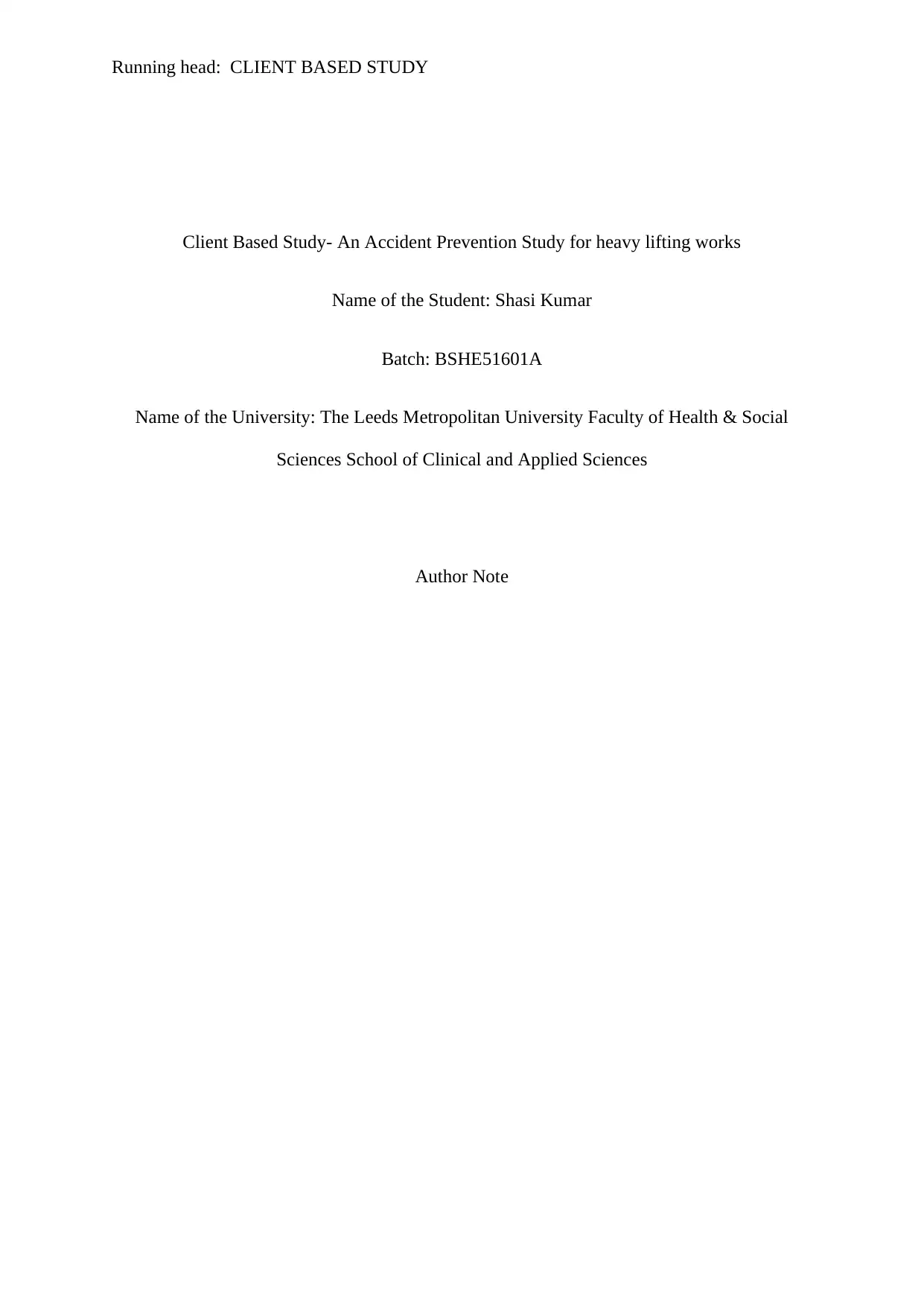
Running head: CLIENT BASED STUDY
Client Based Study- An Accident Prevention Study for heavy lifting works
Name of the Student: Shasi Kumar
Batch: BSHE51601A
Name of the University: The Leeds Metropolitan University Faculty of Health & Social
Sciences School of Clinical and Applied Sciences
Author Note
Client Based Study- An Accident Prevention Study for heavy lifting works
Name of the Student: Shasi Kumar
Batch: BSHE51601A
Name of the University: The Leeds Metropolitan University Faculty of Health & Social
Sciences School of Clinical and Applied Sciences
Author Note
Secure Best Marks with AI Grader
Need help grading? Try our AI Grader for instant feedback on your assignments.
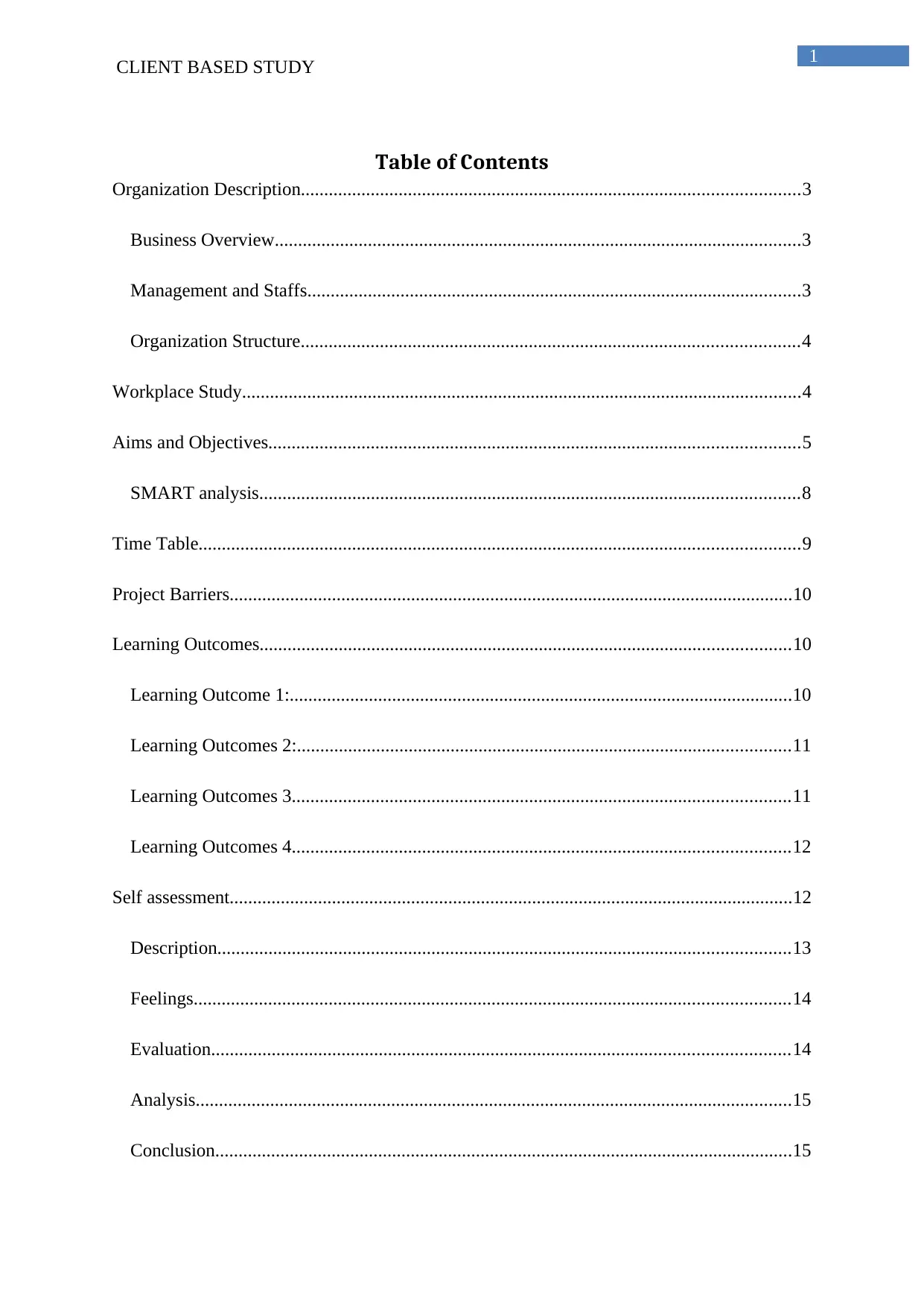
1
CLIENT BASED STUDY
Table of Contents
Organization Description...........................................................................................................3
Business Overview.................................................................................................................3
Management and Staffs..........................................................................................................3
Organization Structure...........................................................................................................4
Workplace Study........................................................................................................................4
Aims and Objectives..................................................................................................................5
SMART analysis....................................................................................................................8
Time Table.................................................................................................................................9
Project Barriers.........................................................................................................................10
Learning Outcomes..................................................................................................................10
Learning Outcome 1:............................................................................................................10
Learning Outcomes 2:..........................................................................................................11
Learning Outcomes 3...........................................................................................................11
Learning Outcomes 4...........................................................................................................12
Self assessment.........................................................................................................................12
Description...........................................................................................................................13
Feelings................................................................................................................................14
Evaluation............................................................................................................................14
Analysis................................................................................................................................15
Conclusion............................................................................................................................15
CLIENT BASED STUDY
Table of Contents
Organization Description...........................................................................................................3
Business Overview.................................................................................................................3
Management and Staffs..........................................................................................................3
Organization Structure...........................................................................................................4
Workplace Study........................................................................................................................4
Aims and Objectives..................................................................................................................5
SMART analysis....................................................................................................................8
Time Table.................................................................................................................................9
Project Barriers.........................................................................................................................10
Learning Outcomes..................................................................................................................10
Learning Outcome 1:............................................................................................................10
Learning Outcomes 2:..........................................................................................................11
Learning Outcomes 3...........................................................................................................11
Learning Outcomes 4...........................................................................................................12
Self assessment.........................................................................................................................12
Description...........................................................................................................................13
Feelings................................................................................................................................14
Evaluation............................................................................................................................14
Analysis................................................................................................................................15
Conclusion............................................................................................................................15
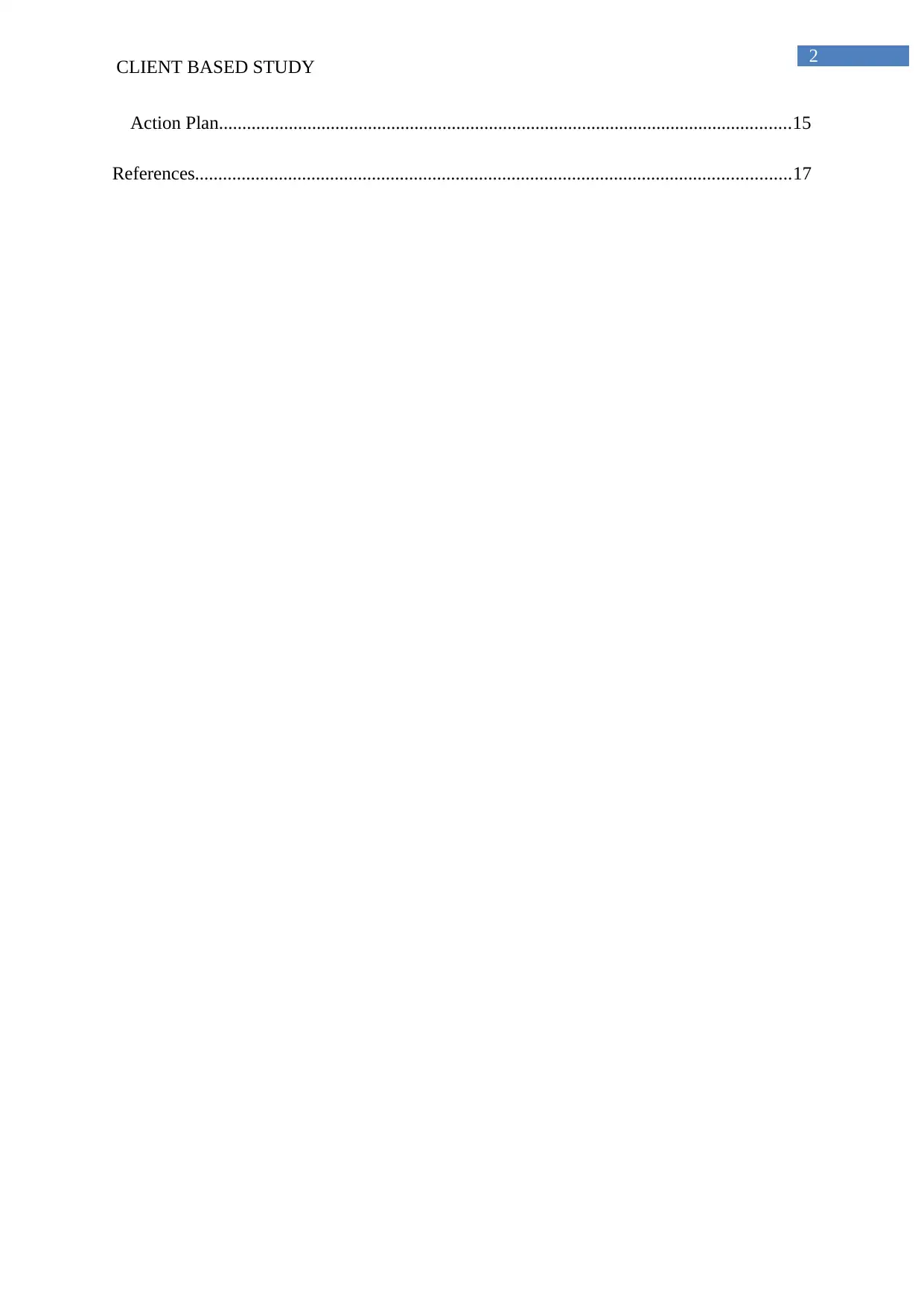
2
CLIENT BASED STUDY
Action Plan...........................................................................................................................15
References................................................................................................................................17
CLIENT BASED STUDY
Action Plan...........................................................................................................................15
References................................................................................................................................17

3
CLIENT BASED STUDY
Organization Description
Business Overview
The organization that I have chosen is GT Steel Construction Group Limited. GT
Steel Construction Group Limited is an independent, private limited organization. This
structural steel fabricator company is operates from Singapore and was established in the year
of 2003. The company specializes in providing innovative design, supply, fabrication and
installation of wide range of standard and custom-made structural steel works (Gt-
steel.com.sg. 2017).
GT Steel Construction Group Limited is an ISO 9001:2008, ISO 14001:2004,
OHSAS 18001:2007 certified organization. Singapore Structural Steel Society has accredited
this organization as the steel fabricator of the highest level ‘S1’ category. The Workplace
Safety &Health Council has also awarded it as the ‘BiZsafe Star’ certified company (Gt-
steel.com.sg. 2017).
Management and Staffs
The organization consists of 110 employees. Out of them, 70 are direct workers.
Moreover, among those 70 odd workers, 30 are doing the fabrications of structural steel at
workshop and the remaining 40 are deployed at the project sites. The remaining 40 hold
managerial and supervisory level pots and is inclusive of a technical team. This technical
team contains drafts man, includes project team with the respective project managers,
supervisors, safety coordinators. They also have various separate departments like logistic,
store/purchaser, quality assurance & control. The direct workers and the other managerial
/supervisory roles are being directly employed by the organization for more than 10 years and
all of them have practical execution knowledge (Gt-steel.com.sg. 2017).
CLIENT BASED STUDY
Organization Description
Business Overview
The organization that I have chosen is GT Steel Construction Group Limited. GT
Steel Construction Group Limited is an independent, private limited organization. This
structural steel fabricator company is operates from Singapore and was established in the year
of 2003. The company specializes in providing innovative design, supply, fabrication and
installation of wide range of standard and custom-made structural steel works (Gt-
steel.com.sg. 2017).
GT Steel Construction Group Limited is an ISO 9001:2008, ISO 14001:2004,
OHSAS 18001:2007 certified organization. Singapore Structural Steel Society has accredited
this organization as the steel fabricator of the highest level ‘S1’ category. The Workplace
Safety &Health Council has also awarded it as the ‘BiZsafe Star’ certified company (Gt-
steel.com.sg. 2017).
Management and Staffs
The organization consists of 110 employees. Out of them, 70 are direct workers.
Moreover, among those 70 odd workers, 30 are doing the fabrications of structural steel at
workshop and the remaining 40 are deployed at the project sites. The remaining 40 hold
managerial and supervisory level pots and is inclusive of a technical team. This technical
team contains drafts man, includes project team with the respective project managers,
supervisors, safety coordinators. They also have various separate departments like logistic,
store/purchaser, quality assurance & control. The direct workers and the other managerial
/supervisory roles are being directly employed by the organization for more than 10 years and
all of them have practical execution knowledge (Gt-steel.com.sg. 2017).
Secure Best Marks with AI Grader
Need help grading? Try our AI Grader for instant feedback on your assignments.
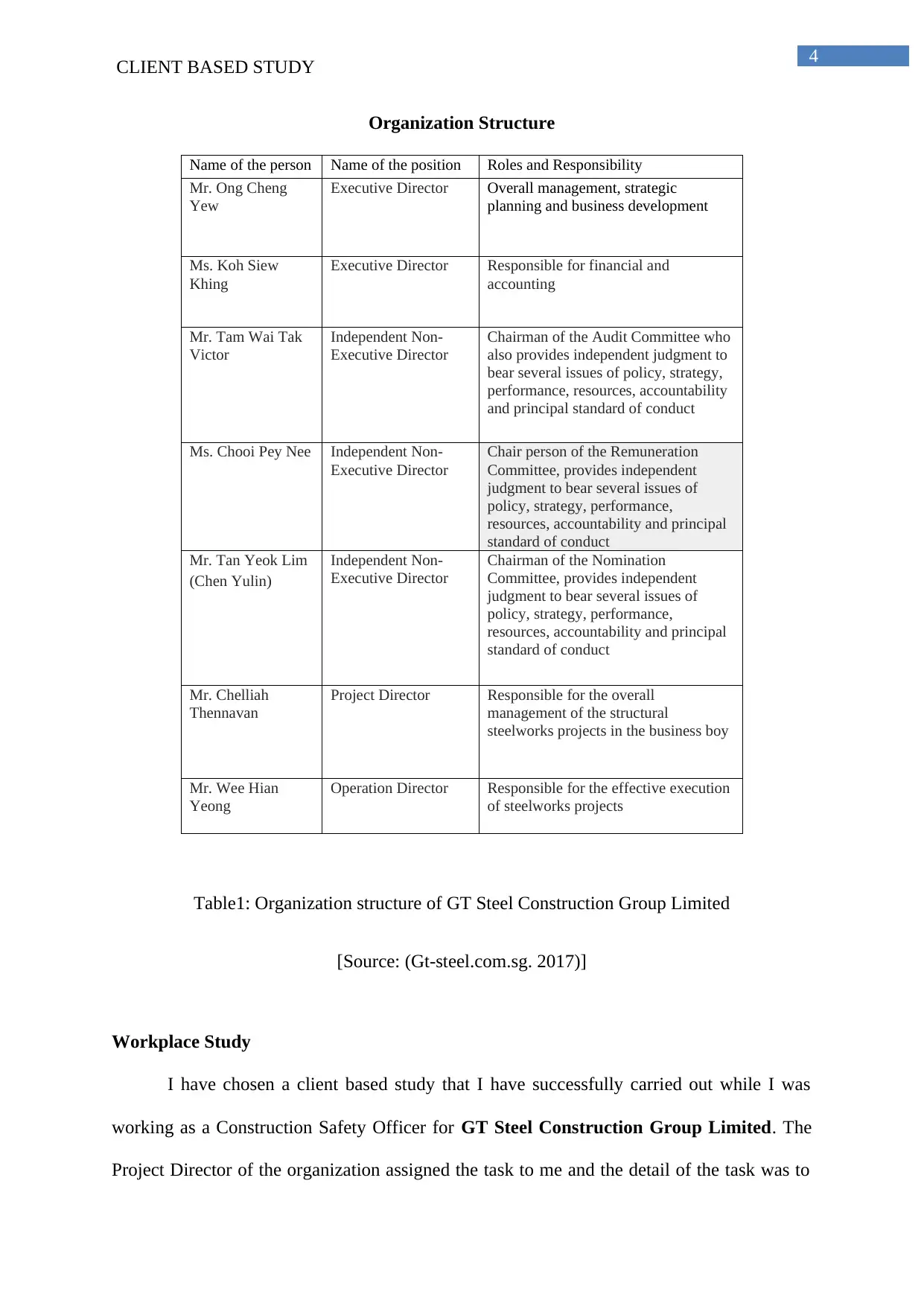
4
CLIENT BASED STUDY
Organization Structure
Name of the person Name of the position Roles and Responsibility
Mr. Ong Cheng
Yew
Executive Director Overall management, strategic
planning and business development
Ms. Koh Siew
Khing
Executive Director Responsible for financial and
accounting
Mr. Tam Wai Tak
Victor
Independent Non-
Executive Director
Chairman of the Audit Committee who
also provides independent judgment to
bear several issues of policy, strategy,
performance, resources, accountability
and principal standard of conduct
Ms. Chooi Pey Nee Independent Non-
Executive Director
Chair person of the Remuneration
Committee, provides independent
judgment to bear several issues of
policy, strategy, performance,
resources, accountability and principal
standard of conduct
Mr. Tan Yeok Lim
(Chen Yulin)
Independent Non-
Executive Director
Chairman of the Nomination
Committee, provides independent
judgment to bear several issues of
policy, strategy, performance,
resources, accountability and principal
standard of conduct
Mr. Chelliah
Thennavan
Project Director Responsible for the overall
management of the structural
steelworks projects in the business boy
Mr. Wee Hian
Yeong
Operation Director Responsible for the effective execution
of steelworks projects
Table1: Organization structure of GT Steel Construction Group Limited
[Source: (Gt-steel.com.sg. 2017)]
Workplace Study
I have chosen a client based study that I have successfully carried out while I was
working as a Construction Safety Officer for GT Steel Construction Group Limited. The
Project Director of the organization assigned the task to me and the detail of the task was to
CLIENT BASED STUDY
Organization Structure
Name of the person Name of the position Roles and Responsibility
Mr. Ong Cheng
Yew
Executive Director Overall management, strategic
planning and business development
Ms. Koh Siew
Khing
Executive Director Responsible for financial and
accounting
Mr. Tam Wai Tak
Victor
Independent Non-
Executive Director
Chairman of the Audit Committee who
also provides independent judgment to
bear several issues of policy, strategy,
performance, resources, accountability
and principal standard of conduct
Ms. Chooi Pey Nee Independent Non-
Executive Director
Chair person of the Remuneration
Committee, provides independent
judgment to bear several issues of
policy, strategy, performance,
resources, accountability and principal
standard of conduct
Mr. Tan Yeok Lim
(Chen Yulin)
Independent Non-
Executive Director
Chairman of the Nomination
Committee, provides independent
judgment to bear several issues of
policy, strategy, performance,
resources, accountability and principal
standard of conduct
Mr. Chelliah
Thennavan
Project Director Responsible for the overall
management of the structural
steelworks projects in the business boy
Mr. Wee Hian
Yeong
Operation Director Responsible for the effective execution
of steelworks projects
Table1: Organization structure of GT Steel Construction Group Limited
[Source: (Gt-steel.com.sg. 2017)]
Workplace Study
I have chosen a client based study that I have successfully carried out while I was
working as a Construction Safety Officer for GT Steel Construction Group Limited. The
Project Director of the organization assigned the task to me and the detail of the task was to
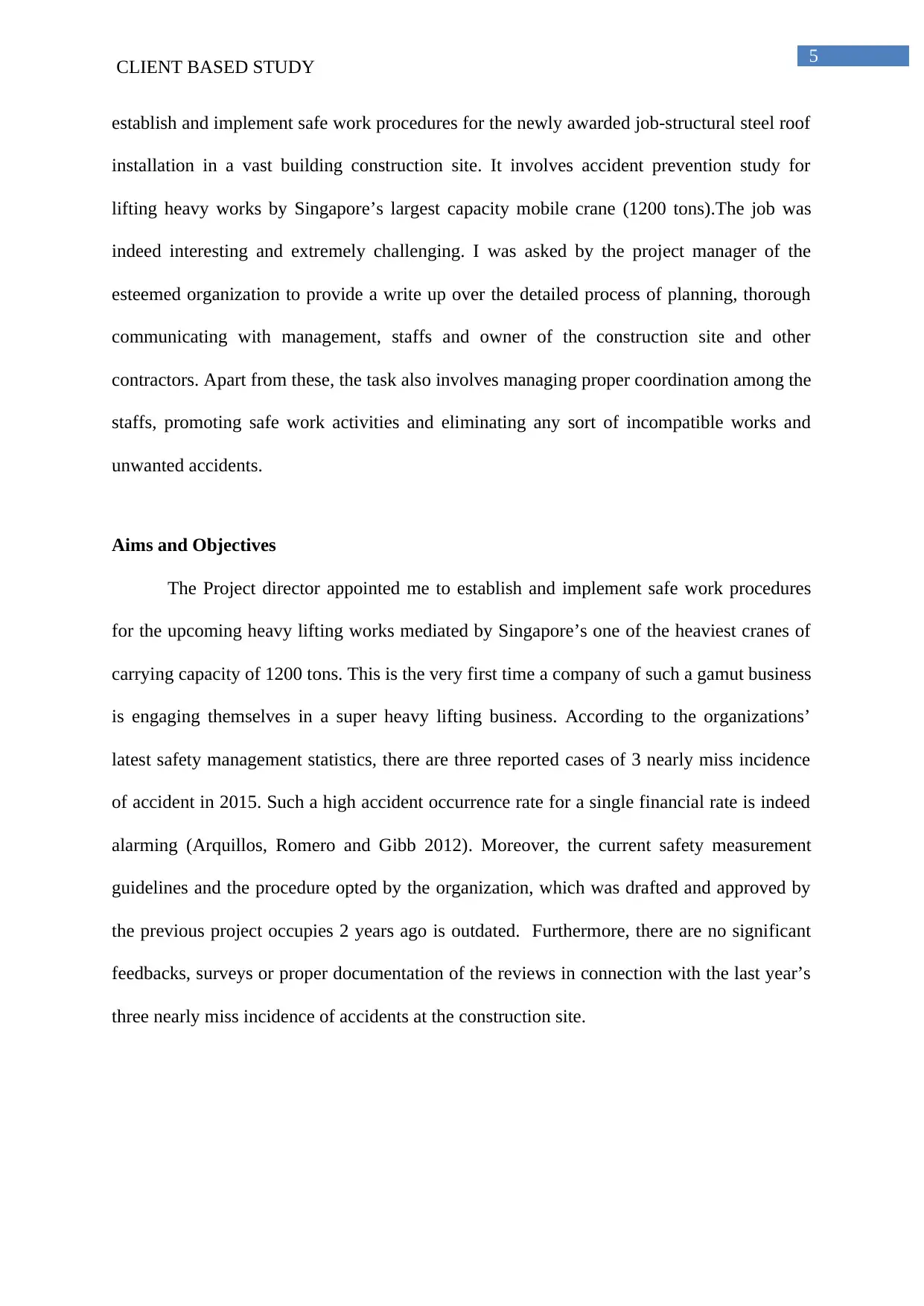
5
CLIENT BASED STUDY
establish and implement safe work procedures for the newly awarded job-structural steel roof
installation in a vast building construction site. It involves accident prevention study for
lifting heavy works by Singapore’s largest capacity mobile crane (1200 tons).The job was
indeed interesting and extremely challenging. I was asked by the project manager of the
esteemed organization to provide a write up over the detailed process of planning, thorough
communicating with management, staffs and owner of the construction site and other
contractors. Apart from these, the task also involves managing proper coordination among the
staffs, promoting safe work activities and eliminating any sort of incompatible works and
unwanted accidents.
Aims and Objectives
The Project director appointed me to establish and implement safe work procedures
for the upcoming heavy lifting works mediated by Singapore’s one of the heaviest cranes of
carrying capacity of 1200 tons. This is the very first time a company of such a gamut business
is engaging themselves in a super heavy lifting business. According to the organizations’
latest safety management statistics, there are three reported cases of 3 nearly miss incidence
of accident in 2015. Such a high accident occurrence rate for a single financial rate is indeed
alarming (Arquillos, Romero and Gibb 2012). Moreover, the current safety measurement
guidelines and the procedure opted by the organization, which was drafted and approved by
the previous project occupies 2 years ago is outdated. Furthermore, there are no significant
feedbacks, surveys or proper documentation of the reviews in connection with the last year’s
three nearly miss incidence of accidents at the construction site.
CLIENT BASED STUDY
establish and implement safe work procedures for the newly awarded job-structural steel roof
installation in a vast building construction site. It involves accident prevention study for
lifting heavy works by Singapore’s largest capacity mobile crane (1200 tons).The job was
indeed interesting and extremely challenging. I was asked by the project manager of the
esteemed organization to provide a write up over the detailed process of planning, thorough
communicating with management, staffs and owner of the construction site and other
contractors. Apart from these, the task also involves managing proper coordination among the
staffs, promoting safe work activities and eliminating any sort of incompatible works and
unwanted accidents.
Aims and Objectives
The Project director appointed me to establish and implement safe work procedures
for the upcoming heavy lifting works mediated by Singapore’s one of the heaviest cranes of
carrying capacity of 1200 tons. This is the very first time a company of such a gamut business
is engaging themselves in a super heavy lifting business. According to the organizations’
latest safety management statistics, there are three reported cases of 3 nearly miss incidence
of accident in 2015. Such a high accident occurrence rate for a single financial rate is indeed
alarming (Arquillos, Romero and Gibb 2012). Moreover, the current safety measurement
guidelines and the procedure opted by the organization, which was drafted and approved by
the previous project occupies 2 years ago is outdated. Furthermore, there are no significant
feedbacks, surveys or proper documentation of the reviews in connection with the last year’s
three nearly miss incidence of accidents at the construction site.
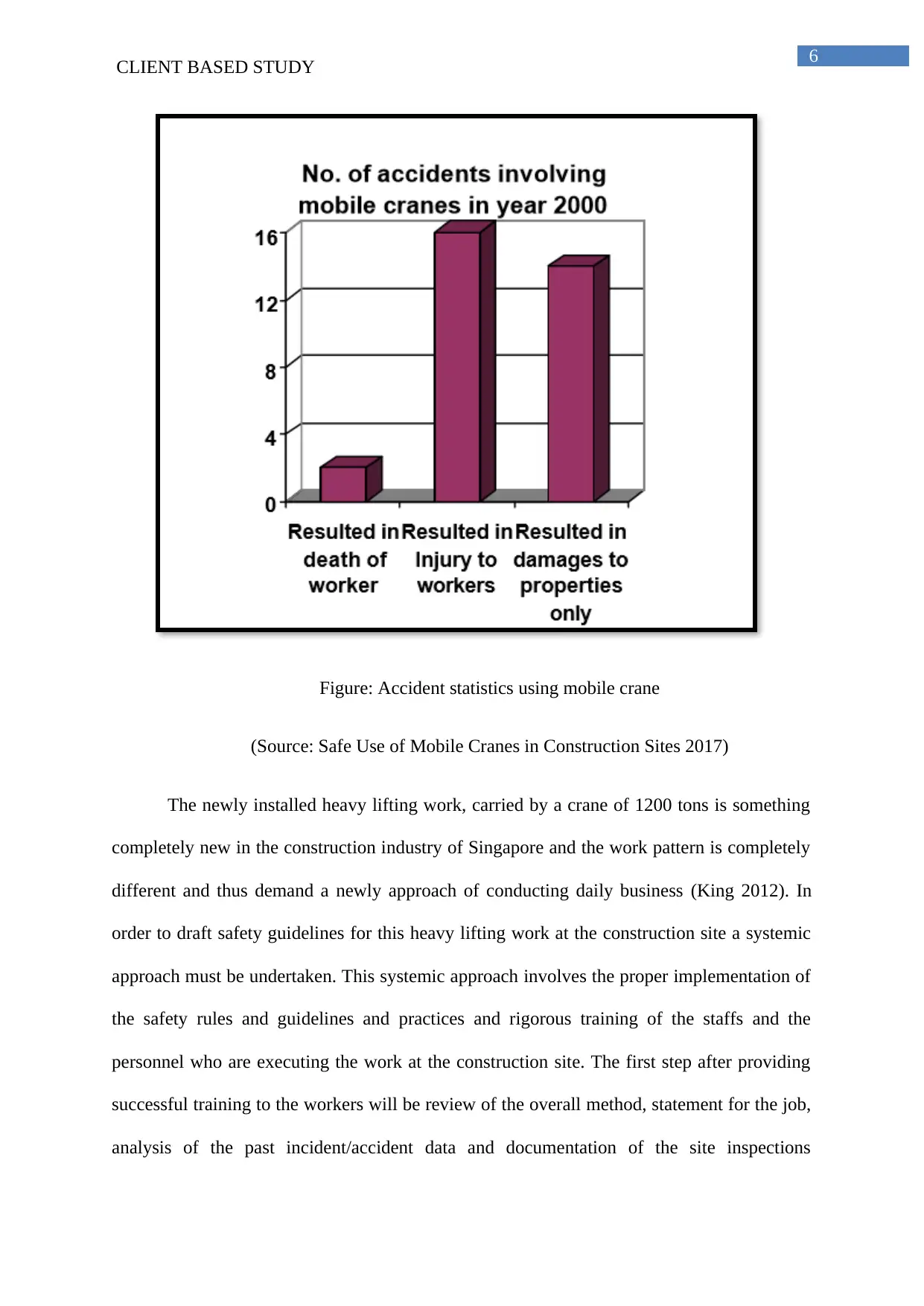
6
CLIENT BASED STUDY
Figure: Accident statistics using mobile crane
(Source: Safe Use of Mobile Cranes in Construction Sites 2017)
The newly installed heavy lifting work, carried by a crane of 1200 tons is something
completely new in the construction industry of Singapore and the work pattern is completely
different and thus demand a newly approach of conducting daily business (King 2012). In
order to draft safety guidelines for this heavy lifting work at the construction site a systemic
approach must be undertaken. This systemic approach involves the proper implementation of
the safety rules and guidelines and practices and rigorous training of the staffs and the
personnel who are executing the work at the construction site. The first step after providing
successful training to the workers will be review of the overall method, statement for the job,
analysis of the past incident/accident data and documentation of the site inspections
CLIENT BASED STUDY
Figure: Accident statistics using mobile crane
(Source: Safe Use of Mobile Cranes in Construction Sites 2017)
The newly installed heavy lifting work, carried by a crane of 1200 tons is something
completely new in the construction industry of Singapore and the work pattern is completely
different and thus demand a newly approach of conducting daily business (King 2012). In
order to draft safety guidelines for this heavy lifting work at the construction site a systemic
approach must be undertaken. This systemic approach involves the proper implementation of
the safety rules and guidelines and practices and rigorous training of the staffs and the
personnel who are executing the work at the construction site. The first step after providing
successful training to the workers will be review of the overall method, statement for the job,
analysis of the past incident/accident data and documentation of the site inspections
Paraphrase This Document
Need a fresh take? Get an instant paraphrase of this document with our AI Paraphraser
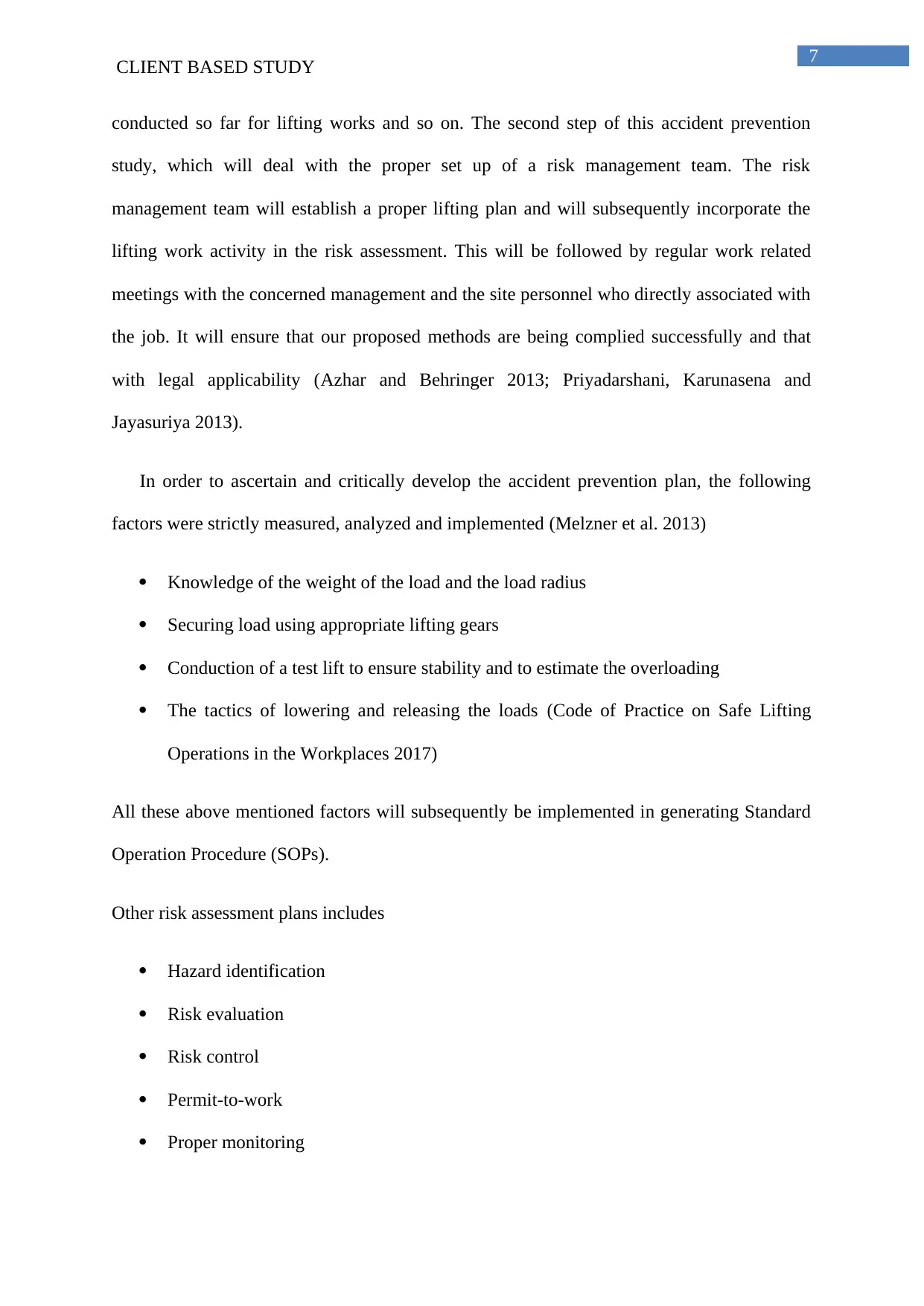
7
CLIENT BASED STUDY
conducted so far for lifting works and so on. The second step of this accident prevention
study, which will deal with the proper set up of a risk management team. The risk
management team will establish a proper lifting plan and will subsequently incorporate the
lifting work activity in the risk assessment. This will be followed by regular work related
meetings with the concerned management and the site personnel who directly associated with
the job. It will ensure that our proposed methods are being complied successfully and that
with legal applicability (Azhar and Behringer 2013; Priyadarshani, Karunasena and
Jayasuriya 2013).
In order to ascertain and critically develop the accident prevention plan, the following
factors were strictly measured, analyzed and implemented (Melzner et al. 2013)
Knowledge of the weight of the load and the load radius
Securing load using appropriate lifting gears
Conduction of a test lift to ensure stability and to estimate the overloading
The tactics of lowering and releasing the loads (Code of Practice on Safe Lifting
Operations in the Workplaces 2017)
All these above mentioned factors will subsequently be implemented in generating Standard
Operation Procedure (SOPs).
Other risk assessment plans includes
Hazard identification
Risk evaluation
Risk control
Permit-to-work
Proper monitoring
CLIENT BASED STUDY
conducted so far for lifting works and so on. The second step of this accident prevention
study, which will deal with the proper set up of a risk management team. The risk
management team will establish a proper lifting plan and will subsequently incorporate the
lifting work activity in the risk assessment. This will be followed by regular work related
meetings with the concerned management and the site personnel who directly associated with
the job. It will ensure that our proposed methods are being complied successfully and that
with legal applicability (Azhar and Behringer 2013; Priyadarshani, Karunasena and
Jayasuriya 2013).
In order to ascertain and critically develop the accident prevention plan, the following
factors were strictly measured, analyzed and implemented (Melzner et al. 2013)
Knowledge of the weight of the load and the load radius
Securing load using appropriate lifting gears
Conduction of a test lift to ensure stability and to estimate the overloading
The tactics of lowering and releasing the loads (Code of Practice on Safe Lifting
Operations in the Workplaces 2017)
All these above mentioned factors will subsequently be implemented in generating Standard
Operation Procedure (SOPs).
Other risk assessment plans includes
Hazard identification
Risk evaluation
Risk control
Permit-to-work
Proper monitoring

8
CLIENT BASED STUDY
Training of the staffs
Reviewing (Guo et al., 2012; Park and Kim, 2013)
SMART analysis
The objective “An accident prevention study for heavy lifting works”.
Specific: Construction business has several safety strategies in order to curb the accidents at
the site of work. However, there are no specific strategies to control the accident risks at the
heavy lifting works with 1200 tons crane. Since, such heavy scale machine is something new
to Singapore, this kind of accident prevention study will help to design a specific yet target
oriented plan.
Measurable: In this said research study, the management stuffs and the workers who are
directly involved or participating at the construction site on a regular basis will be trained
religiously.
Achievable: The target is indeed achievable and is estimated to get complete within three
months from the pre-start of the project works starting from May 2015 and completing in
September 2016.
Relevant: The projector this accident prevention study is being conducted in order to
minimize the chances of accidents at the site of heavy lifting works in the construction
business (Othman 2012).
Time Frame: Since the time frame is limited in comparison to the number of staffs, the
desired outcome will be a bit difficult to achieve. But through practice of the safety measures
as outlined by us will surely negate the chances of fatal accidents in the long run (Swuste
2013).
CLIENT BASED STUDY
Training of the staffs
Reviewing (Guo et al., 2012; Park and Kim, 2013)
SMART analysis
The objective “An accident prevention study for heavy lifting works”.
Specific: Construction business has several safety strategies in order to curb the accidents at
the site of work. However, there are no specific strategies to control the accident risks at the
heavy lifting works with 1200 tons crane. Since, such heavy scale machine is something new
to Singapore, this kind of accident prevention study will help to design a specific yet target
oriented plan.
Measurable: In this said research study, the management stuffs and the workers who are
directly involved or participating at the construction site on a regular basis will be trained
religiously.
Achievable: The target is indeed achievable and is estimated to get complete within three
months from the pre-start of the project works starting from May 2015 and completing in
September 2016.
Relevant: The projector this accident prevention study is being conducted in order to
minimize the chances of accidents at the site of heavy lifting works in the construction
business (Othman 2012).
Time Frame: Since the time frame is limited in comparison to the number of staffs, the
desired outcome will be a bit difficult to achieve. But through practice of the safety measures
as outlined by us will surely negate the chances of fatal accidents in the long run (Swuste
2013).
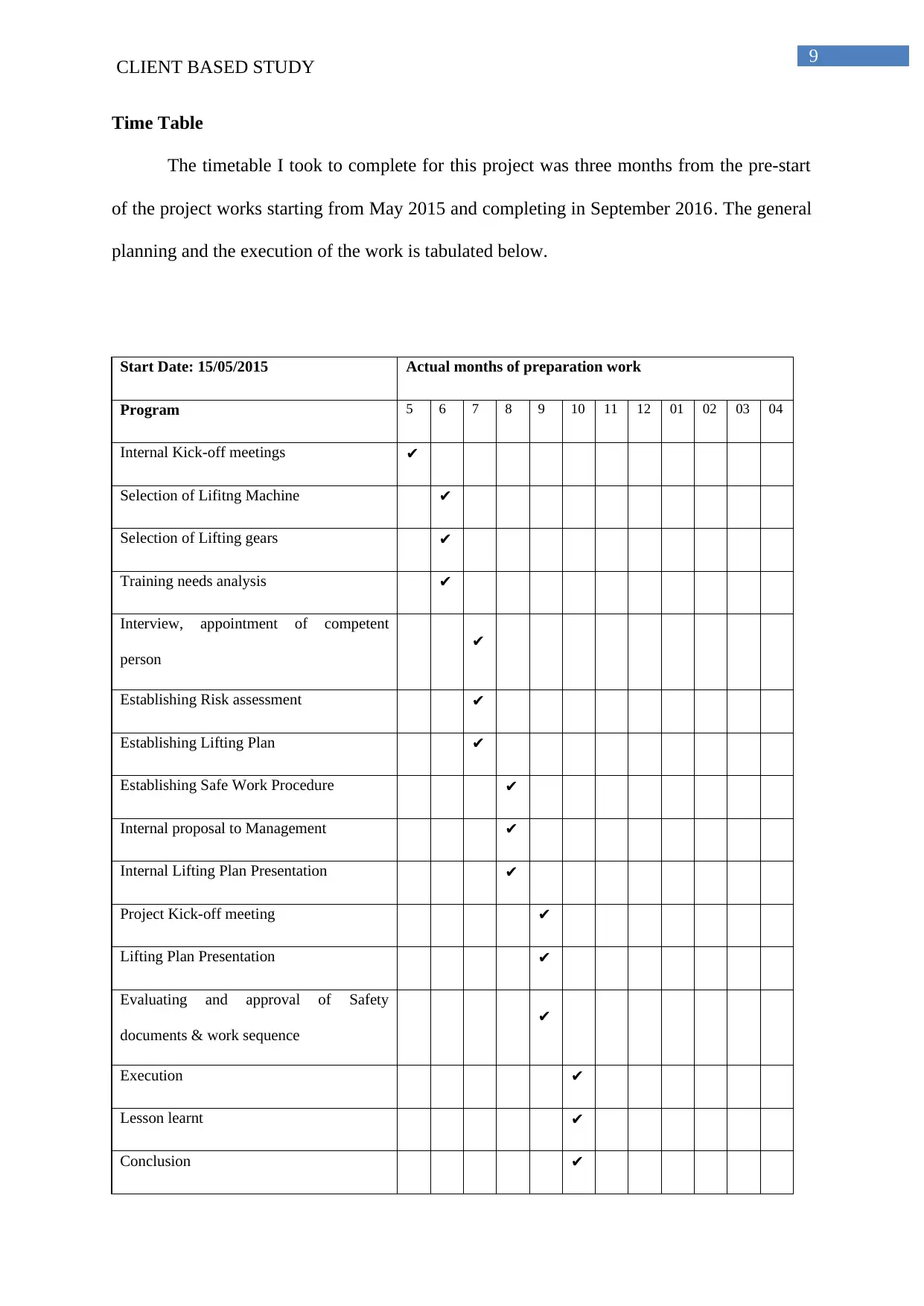
9
CLIENT BASED STUDY
Time Table
The timetable I took to complete for this project was three months from the pre-start
of the project works starting from May 2015 and completing in September 2016. The general
planning and the execution of the work is tabulated below.
Start Date: 15/05/2015 Actual months of preparation work
Program 5 6 7 8 9 10 11 12 01 02 03 04
Internal Kick-off meetings ✔
Selection of Lifitng Machine ✔
Selection of Lifting gears ✔
Training needs analysis ✔
Interview, appointment of competent
person
✔
Establishing Risk assessment ✔
Establishing Lifting Plan ✔
Establishing Safe Work Procedure ✔
Internal proposal to Management ✔
Internal Lifting Plan Presentation ✔
Project Kick-off meeting ✔
Lifting Plan Presentation ✔
Evaluating and approval of Safety
documents & work sequence
✔
Execution ✔
Lesson learnt ✔
Conclusion ✔
CLIENT BASED STUDY
Time Table
The timetable I took to complete for this project was three months from the pre-start
of the project works starting from May 2015 and completing in September 2016. The general
planning and the execution of the work is tabulated below.
Start Date: 15/05/2015 Actual months of preparation work
Program 5 6 7 8 9 10 11 12 01 02 03 04
Internal Kick-off meetings ✔
Selection of Lifitng Machine ✔
Selection of Lifting gears ✔
Training needs analysis ✔
Interview, appointment of competent
person
✔
Establishing Risk assessment ✔
Establishing Lifting Plan ✔
Establishing Safe Work Procedure ✔
Internal proposal to Management ✔
Internal Lifting Plan Presentation ✔
Project Kick-off meeting ✔
Lifting Plan Presentation ✔
Evaluating and approval of Safety
documents & work sequence
✔
Execution ✔
Lesson learnt ✔
Conclusion ✔
Secure Best Marks with AI Grader
Need help grading? Try our AI Grader for instant feedback on your assignments.
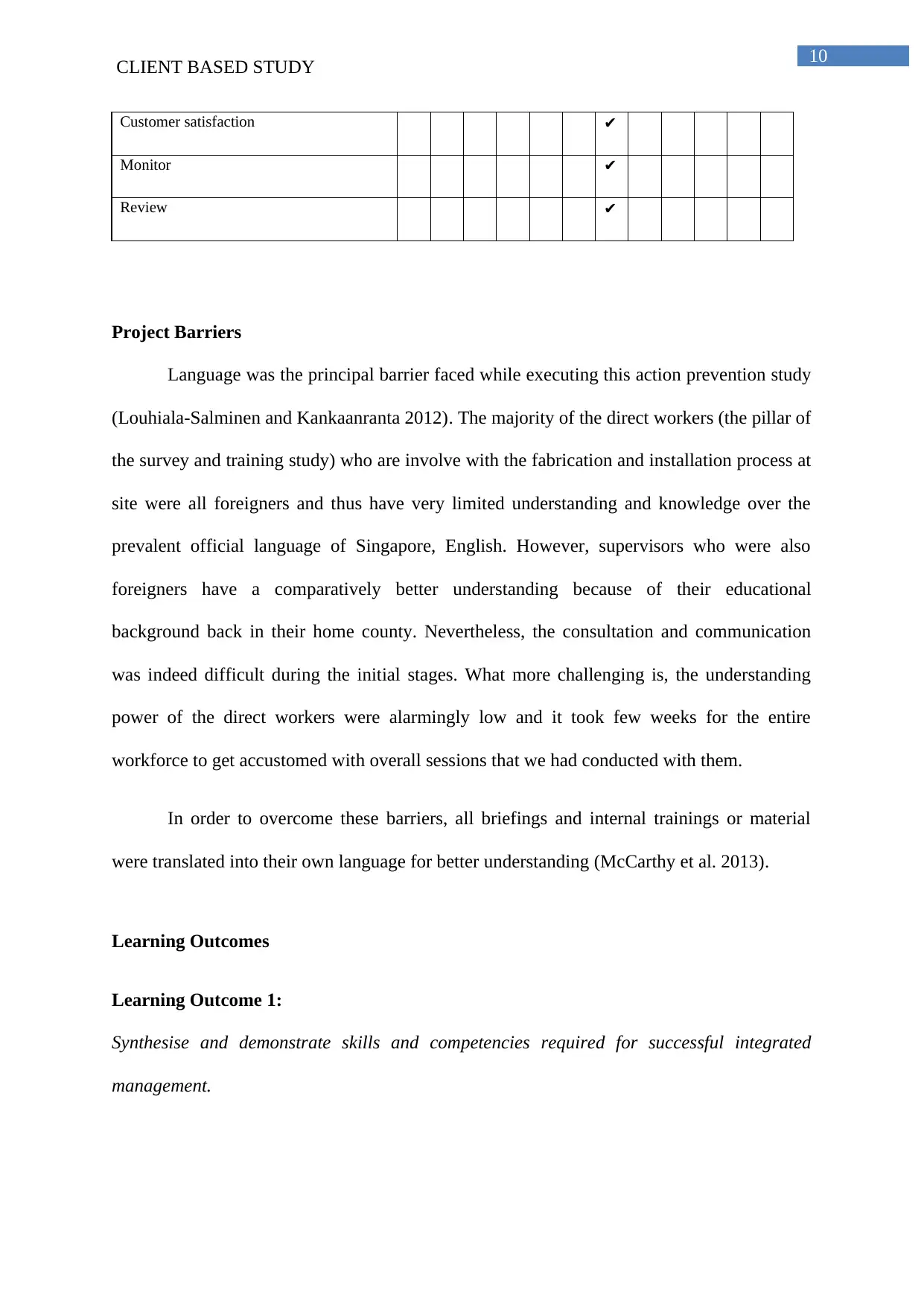
10
CLIENT BASED STUDY
Customer satisfaction ✔
Monitor ✔
Review ✔
Project Barriers
Language was the principal barrier faced while executing this action prevention study
(Louhiala-Salminen and Kankaanranta 2012). The majority of the direct workers (the pillar of
the survey and training study) who are involve with the fabrication and installation process at
site were all foreigners and thus have very limited understanding and knowledge over the
prevalent official language of Singapore, English. However, supervisors who were also
foreigners have a comparatively better understanding because of their educational
background back in their home county. Nevertheless, the consultation and communication
was indeed difficult during the initial stages. What more challenging is, the understanding
power of the direct workers were alarmingly low and it took few weeks for the entire
workforce to get accustomed with overall sessions that we had conducted with them.
In order to overcome these barriers, all briefings and internal trainings or material
were translated into their own language for better understanding (McCarthy et al. 2013).
Learning Outcomes
Learning Outcome 1:
Synthesise and demonstrate skills and competencies required for successful integrated
management.
CLIENT BASED STUDY
Customer satisfaction ✔
Monitor ✔
Review ✔
Project Barriers
Language was the principal barrier faced while executing this action prevention study
(Louhiala-Salminen and Kankaanranta 2012). The majority of the direct workers (the pillar of
the survey and training study) who are involve with the fabrication and installation process at
site were all foreigners and thus have very limited understanding and knowledge over the
prevalent official language of Singapore, English. However, supervisors who were also
foreigners have a comparatively better understanding because of their educational
background back in their home county. Nevertheless, the consultation and communication
was indeed difficult during the initial stages. What more challenging is, the understanding
power of the direct workers were alarmingly low and it took few weeks for the entire
workforce to get accustomed with overall sessions that we had conducted with them.
In order to overcome these barriers, all briefings and internal trainings or material
were translated into their own language for better understanding (McCarthy et al. 2013).
Learning Outcomes
Learning Outcome 1:
Synthesise and demonstrate skills and competencies required for successful integrated
management.
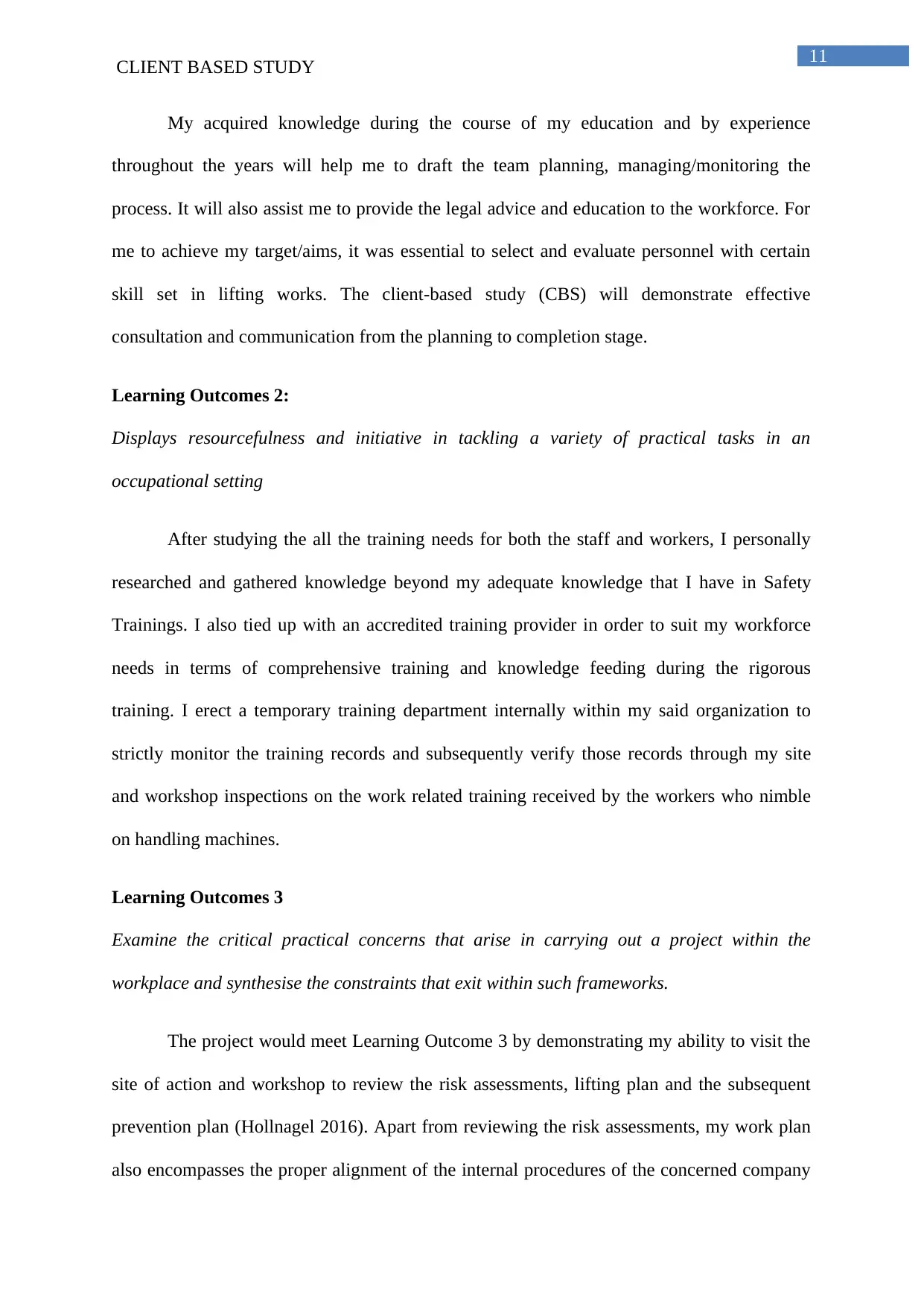
11
CLIENT BASED STUDY
My acquired knowledge during the course of my education and by experience
throughout the years will help me to draft the team planning, managing/monitoring the
process. It will also assist me to provide the legal advice and education to the workforce. For
me to achieve my target/aims, it was essential to select and evaluate personnel with certain
skill set in lifting works. The client-based study (CBS) will demonstrate effective
consultation and communication from the planning to completion stage.
Learning Outcomes 2:
Displays resourcefulness and initiative in tackling a variety of practical tasks in an
occupational setting
After studying the all the training needs for both the staff and workers, I personally
researched and gathered knowledge beyond my adequate knowledge that I have in Safety
Trainings. I also tied up with an accredited training provider in order to suit my workforce
needs in terms of comprehensive training and knowledge feeding during the rigorous
training. I erect a temporary training department internally within my said organization to
strictly monitor the training records and subsequently verify those records through my site
and workshop inspections on the work related training received by the workers who nimble
on handling machines.
Learning Outcomes 3
Examine the critical practical concerns that arise in carrying out a project within the
workplace and synthesise the constraints that exit within such frameworks.
The project would meet Learning Outcome 3 by demonstrating my ability to visit the
site of action and workshop to review the risk assessments, lifting plan and the subsequent
prevention plan (Hollnagel 2016). Apart from reviewing the risk assessments, my work plan
also encompasses the proper alignment of the internal procedures of the concerned company
CLIENT BASED STUDY
My acquired knowledge during the course of my education and by experience
throughout the years will help me to draft the team planning, managing/monitoring the
process. It will also assist me to provide the legal advice and education to the workforce. For
me to achieve my target/aims, it was essential to select and evaluate personnel with certain
skill set in lifting works. The client-based study (CBS) will demonstrate effective
consultation and communication from the planning to completion stage.
Learning Outcomes 2:
Displays resourcefulness and initiative in tackling a variety of practical tasks in an
occupational setting
After studying the all the training needs for both the staff and workers, I personally
researched and gathered knowledge beyond my adequate knowledge that I have in Safety
Trainings. I also tied up with an accredited training provider in order to suit my workforce
needs in terms of comprehensive training and knowledge feeding during the rigorous
training. I erect a temporary training department internally within my said organization to
strictly monitor the training records and subsequently verify those records through my site
and workshop inspections on the work related training received by the workers who nimble
on handling machines.
Learning Outcomes 3
Examine the critical practical concerns that arise in carrying out a project within the
workplace and synthesise the constraints that exit within such frameworks.
The project would meet Learning Outcome 3 by demonstrating my ability to visit the
site of action and workshop to review the risk assessments, lifting plan and the subsequent
prevention plan (Hollnagel 2016). Apart from reviewing the risk assessments, my work plan
also encompasses the proper alignment of the internal procedures of the concerned company

12
CLIENT BASED STUDY
combined within both client’s procedures and legal framework. The client-based task will be
conducted by me and will revolve around the safety quotient of all the team members
working under the project. I will also train the entire workforce who are involve in the overall
work process.
Learning Outcomes 4
Critically apply knowledge about the practical application and synthesise the different
abilities required to implement the chosen client based tasks.
The project would meet the learning outcome 4 by complying with the legislative and
statutory requirements. Completing risk assessment forms are necessary for such learning
outcomes. As safety is the prime concern is all business, the leader of an enterprise will be
responsible for setting the direction of the safety quotient, how it should be implemented,
practiced and documented. He or she will also look into the continuous refinement and
improvement of this safety quotient bar. By means of this, the responsibility over my
shoulder was extremely challenging and it included handling and coordinating with Human
Resource department head on worker injury claim, salary related issue and the government
agency related safety dispute.
Self assessment
In this particular accident prevention study, I have decided to use Gibbs reflective
model as a template of my reflective writing in reference to the Kolb’s experimental learning
method. Gibbs model fragments the overall process of self-analysis into simplified stages
(Husebø, O'Regan and Nestel 2015; Kolb 2014).
CLIENT BASED STUDY
combined within both client’s procedures and legal framework. The client-based task will be
conducted by me and will revolve around the safety quotient of all the team members
working under the project. I will also train the entire workforce who are involve in the overall
work process.
Learning Outcomes 4
Critically apply knowledge about the practical application and synthesise the different
abilities required to implement the chosen client based tasks.
The project would meet the learning outcome 4 by complying with the legislative and
statutory requirements. Completing risk assessment forms are necessary for such learning
outcomes. As safety is the prime concern is all business, the leader of an enterprise will be
responsible for setting the direction of the safety quotient, how it should be implemented,
practiced and documented. He or she will also look into the continuous refinement and
improvement of this safety quotient bar. By means of this, the responsibility over my
shoulder was extremely challenging and it included handling and coordinating with Human
Resource department head on worker injury claim, salary related issue and the government
agency related safety dispute.
Self assessment
In this particular accident prevention study, I have decided to use Gibbs reflective
model as a template of my reflective writing in reference to the Kolb’s experimental learning
method. Gibbs model fragments the overall process of self-analysis into simplified stages
(Husebø, O'Regan and Nestel 2015; Kolb 2014).
Paraphrase This Document
Need a fresh take? Get an instant paraphrase of this document with our AI Paraphraser
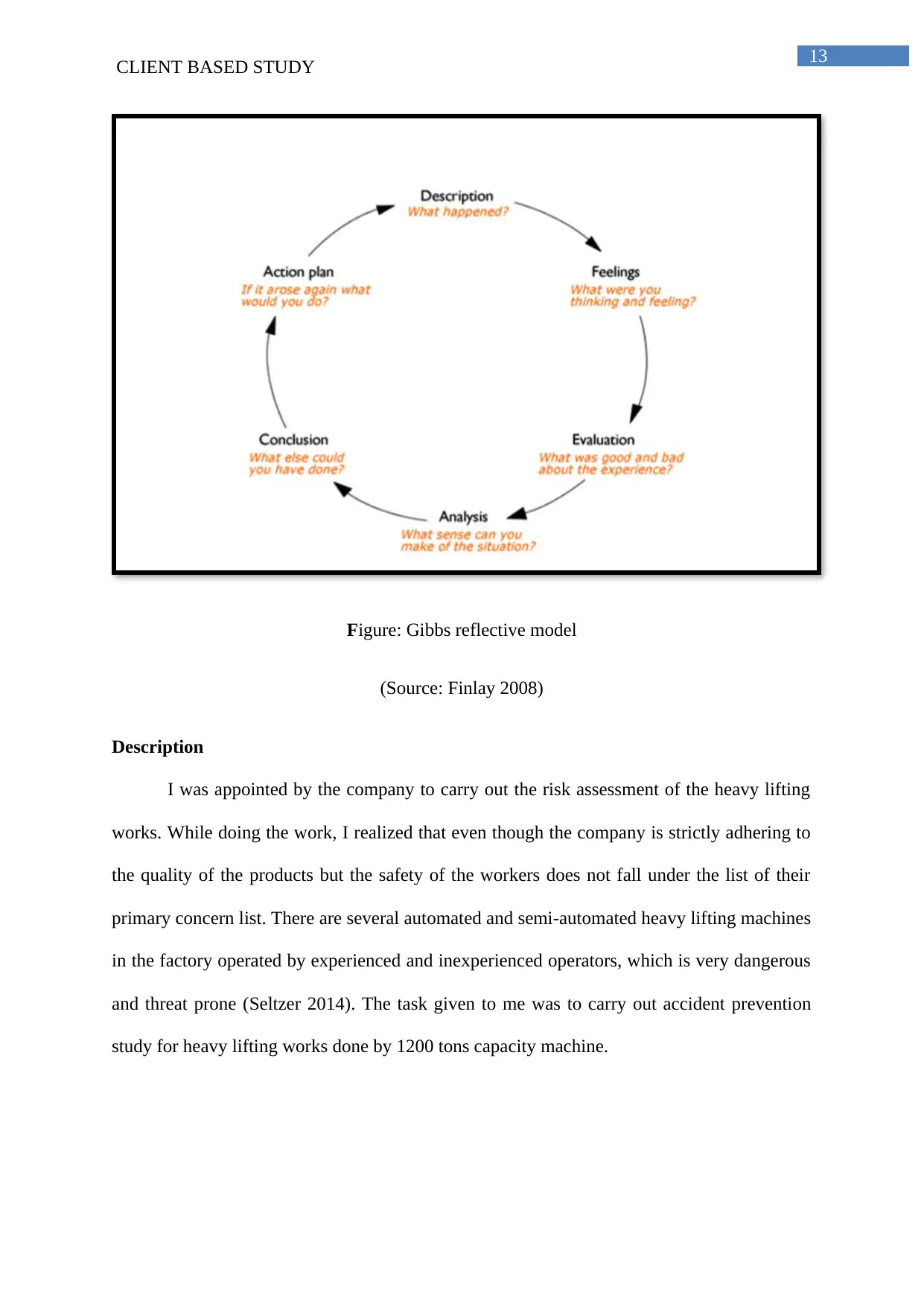
13
CLIENT BASED STUDY
Figure: Gibbs reflective model
(Source: Finlay 2008)
Description
I was appointed by the company to carry out the risk assessment of the heavy lifting
works. While doing the work, I realized that even though the company is strictly adhering to
the quality of the products but the safety of the workers does not fall under the list of their
primary concern list. There are several automated and semi-automated heavy lifting machines
in the factory operated by experienced and inexperienced operators, which is very dangerous
and threat prone (Seltzer 2014). The task given to me was to carry out accident prevention
study for heavy lifting works done by 1200 tons capacity machine.
CLIENT BASED STUDY
Figure: Gibbs reflective model
(Source: Finlay 2008)
Description
I was appointed by the company to carry out the risk assessment of the heavy lifting
works. While doing the work, I realized that even though the company is strictly adhering to
the quality of the products but the safety of the workers does not fall under the list of their
primary concern list. There are several automated and semi-automated heavy lifting machines
in the factory operated by experienced and inexperienced operators, which is very dangerous
and threat prone (Seltzer 2014). The task given to me was to carry out accident prevention
study for heavy lifting works done by 1200 tons capacity machine.
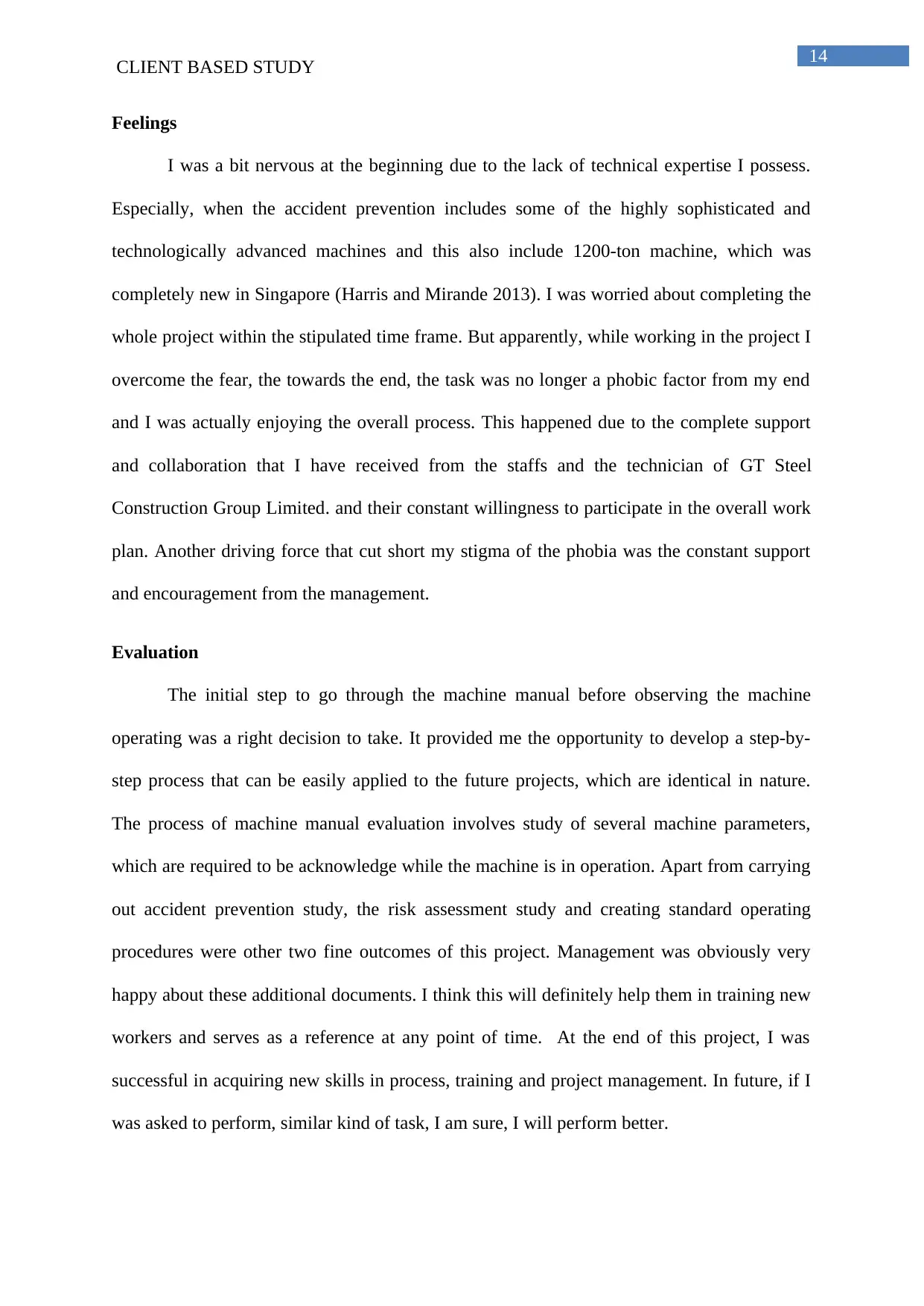
14
CLIENT BASED STUDY
Feelings
I was a bit nervous at the beginning due to the lack of technical expertise I possess.
Especially, when the accident prevention includes some of the highly sophisticated and
technologically advanced machines and this also include 1200-ton machine, which was
completely new in Singapore (Harris and Mirande 2013). I was worried about completing the
whole project within the stipulated time frame. But apparently, while working in the project I
overcome the fear, the towards the end, the task was no longer a phobic factor from my end
and I was actually enjoying the overall process. This happened due to the complete support
and collaboration that I have received from the staffs and the technician of GT Steel
Construction Group Limited. and their constant willingness to participate in the overall work
plan. Another driving force that cut short my stigma of the phobia was the constant support
and encouragement from the management.
Evaluation
The initial step to go through the machine manual before observing the machine
operating was a right decision to take. It provided me the opportunity to develop a step-by-
step process that can be easily applied to the future projects, which are identical in nature.
The process of machine manual evaluation involves study of several machine parameters,
which are required to be acknowledge while the machine is in operation. Apart from carrying
out accident prevention study, the risk assessment study and creating standard operating
procedures were other two fine outcomes of this project. Management was obviously very
happy about these additional documents. I think this will definitely help them in training new
workers and serves as a reference at any point of time. At the end of this project, I was
successful in acquiring new skills in process, training and project management. In future, if I
was asked to perform, similar kind of task, I am sure, I will perform better.
CLIENT BASED STUDY
Feelings
I was a bit nervous at the beginning due to the lack of technical expertise I possess.
Especially, when the accident prevention includes some of the highly sophisticated and
technologically advanced machines and this also include 1200-ton machine, which was
completely new in Singapore (Harris and Mirande 2013). I was worried about completing the
whole project within the stipulated time frame. But apparently, while working in the project I
overcome the fear, the towards the end, the task was no longer a phobic factor from my end
and I was actually enjoying the overall process. This happened due to the complete support
and collaboration that I have received from the staffs and the technician of GT Steel
Construction Group Limited. and their constant willingness to participate in the overall work
plan. Another driving force that cut short my stigma of the phobia was the constant support
and encouragement from the management.
Evaluation
The initial step to go through the machine manual before observing the machine
operating was a right decision to take. It provided me the opportunity to develop a step-by-
step process that can be easily applied to the future projects, which are identical in nature.
The process of machine manual evaluation involves study of several machine parameters,
which are required to be acknowledge while the machine is in operation. Apart from carrying
out accident prevention study, the risk assessment study and creating standard operating
procedures were other two fine outcomes of this project. Management was obviously very
happy about these additional documents. I think this will definitely help them in training new
workers and serves as a reference at any point of time. At the end of this project, I was
successful in acquiring new skills in process, training and project management. In future, if I
was asked to perform, similar kind of task, I am sure, I will perform better.
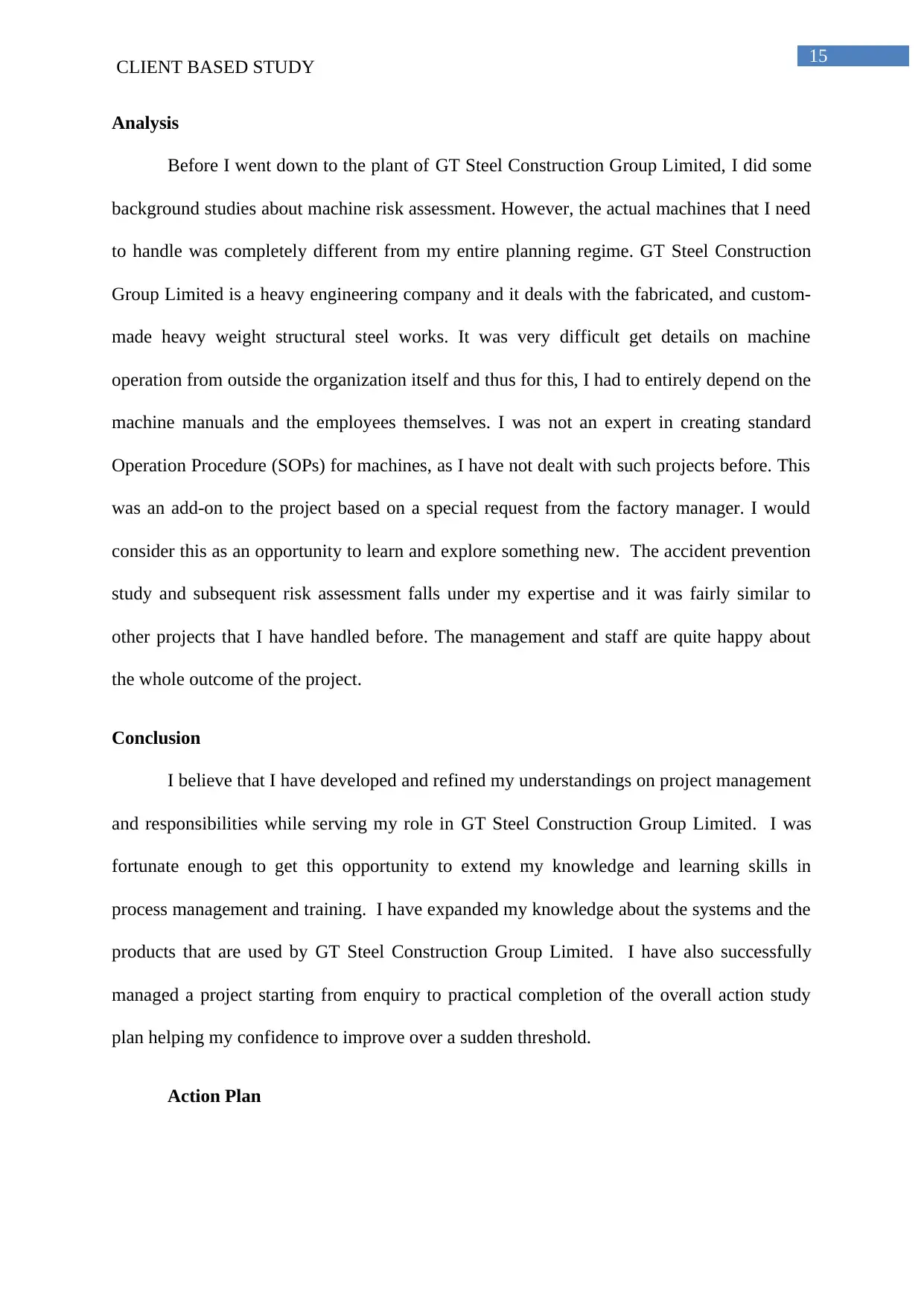
15
CLIENT BASED STUDY
Analysis
Before I went down to the plant of GT Steel Construction Group Limited, I did some
background studies about machine risk assessment. However, the actual machines that I need
to handle was completely different from my entire planning regime. GT Steel Construction
Group Limited is a heavy engineering company and it deals with the fabricated, and custom-
made heavy weight structural steel works. It was very difficult get details on machine
operation from outside the organization itself and thus for this, I had to entirely depend on the
machine manuals and the employees themselves. I was not an expert in creating standard
Operation Procedure (SOPs) for machines, as I have not dealt with such projects before. This
was an add-on to the project based on a special request from the factory manager. I would
consider this as an opportunity to learn and explore something new. The accident prevention
study and subsequent risk assessment falls under my expertise and it was fairly similar to
other projects that I have handled before. The management and staff are quite happy about
the whole outcome of the project.
Conclusion
I believe that I have developed and refined my understandings on project management
and responsibilities while serving my role in GT Steel Construction Group Limited. I was
fortunate enough to get this opportunity to extend my knowledge and learning skills in
process management and training. I have expanded my knowledge about the systems and the
products that are used by GT Steel Construction Group Limited. I have also successfully
managed a project starting from enquiry to practical completion of the overall action study
plan helping my confidence to improve over a sudden threshold.
Action Plan
CLIENT BASED STUDY
Analysis
Before I went down to the plant of GT Steel Construction Group Limited, I did some
background studies about machine risk assessment. However, the actual machines that I need
to handle was completely different from my entire planning regime. GT Steel Construction
Group Limited is a heavy engineering company and it deals with the fabricated, and custom-
made heavy weight structural steel works. It was very difficult get details on machine
operation from outside the organization itself and thus for this, I had to entirely depend on the
machine manuals and the employees themselves. I was not an expert in creating standard
Operation Procedure (SOPs) for machines, as I have not dealt with such projects before. This
was an add-on to the project based on a special request from the factory manager. I would
consider this as an opportunity to learn and explore something new. The accident prevention
study and subsequent risk assessment falls under my expertise and it was fairly similar to
other projects that I have handled before. The management and staff are quite happy about
the whole outcome of the project.
Conclusion
I believe that I have developed and refined my understandings on project management
and responsibilities while serving my role in GT Steel Construction Group Limited. I was
fortunate enough to get this opportunity to extend my knowledge and learning skills in
process management and training. I have expanded my knowledge about the systems and the
products that are used by GT Steel Construction Group Limited. I have also successfully
managed a project starting from enquiry to practical completion of the overall action study
plan helping my confidence to improve over a sudden threshold.
Action Plan
Secure Best Marks with AI Grader
Need help grading? Try our AI Grader for instant feedback on your assignments.
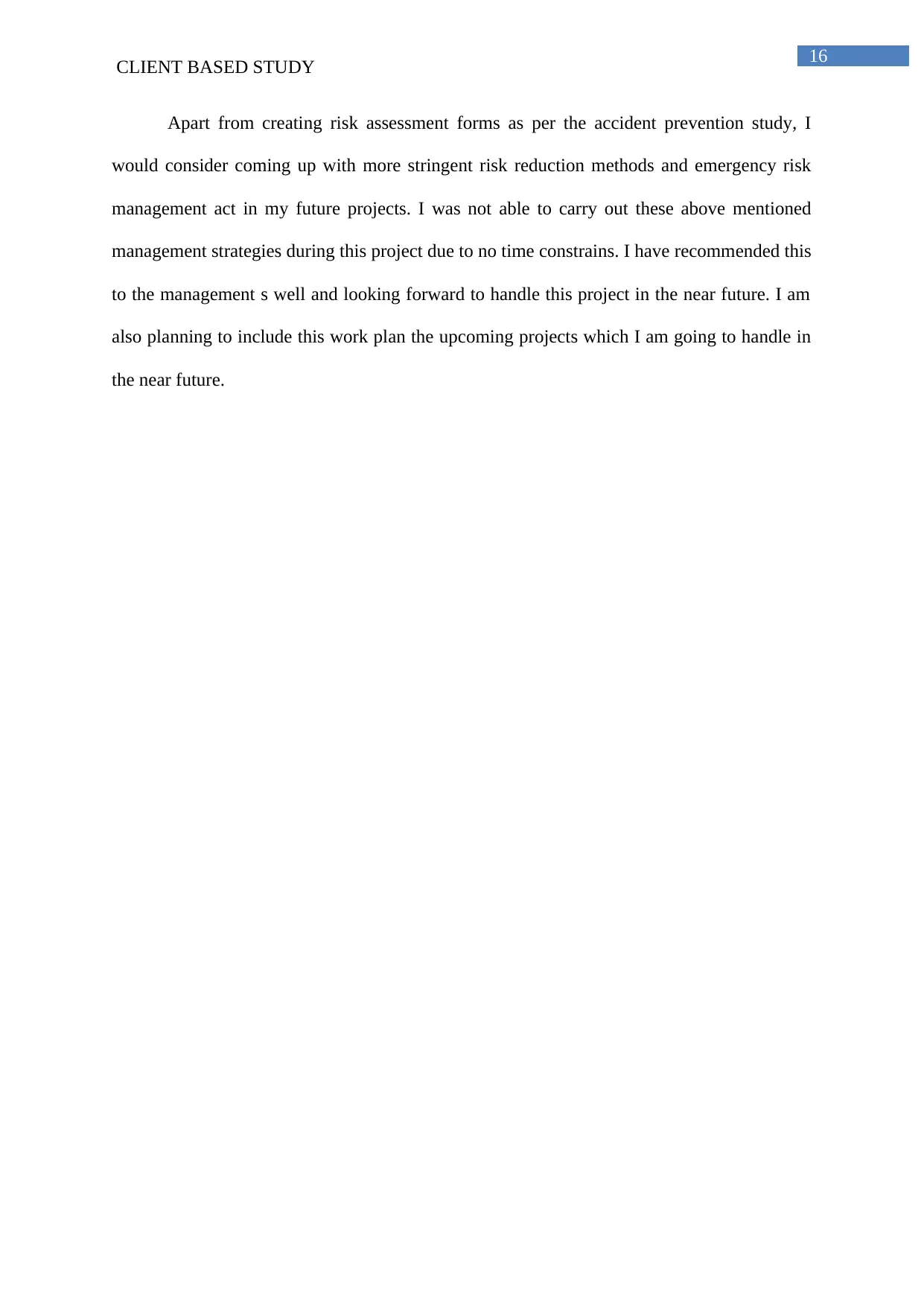
16
CLIENT BASED STUDY
Apart from creating risk assessment forms as per the accident prevention study, I
would consider coming up with more stringent risk reduction methods and emergency risk
management act in my future projects. I was not able to carry out these above mentioned
management strategies during this project due to no time constrains. I have recommended this
to the management s well and looking forward to handle this project in the near future. I am
also planning to include this work plan the upcoming projects which I am going to handle in
the near future.
CLIENT BASED STUDY
Apart from creating risk assessment forms as per the accident prevention study, I
would consider coming up with more stringent risk reduction methods and emergency risk
management act in my future projects. I was not able to carry out these above mentioned
management strategies during this project due to no time constrains. I have recommended this
to the management s well and looking forward to handle this project in the near future. I am
also planning to include this work plan the upcoming projects which I am going to handle in
the near future.
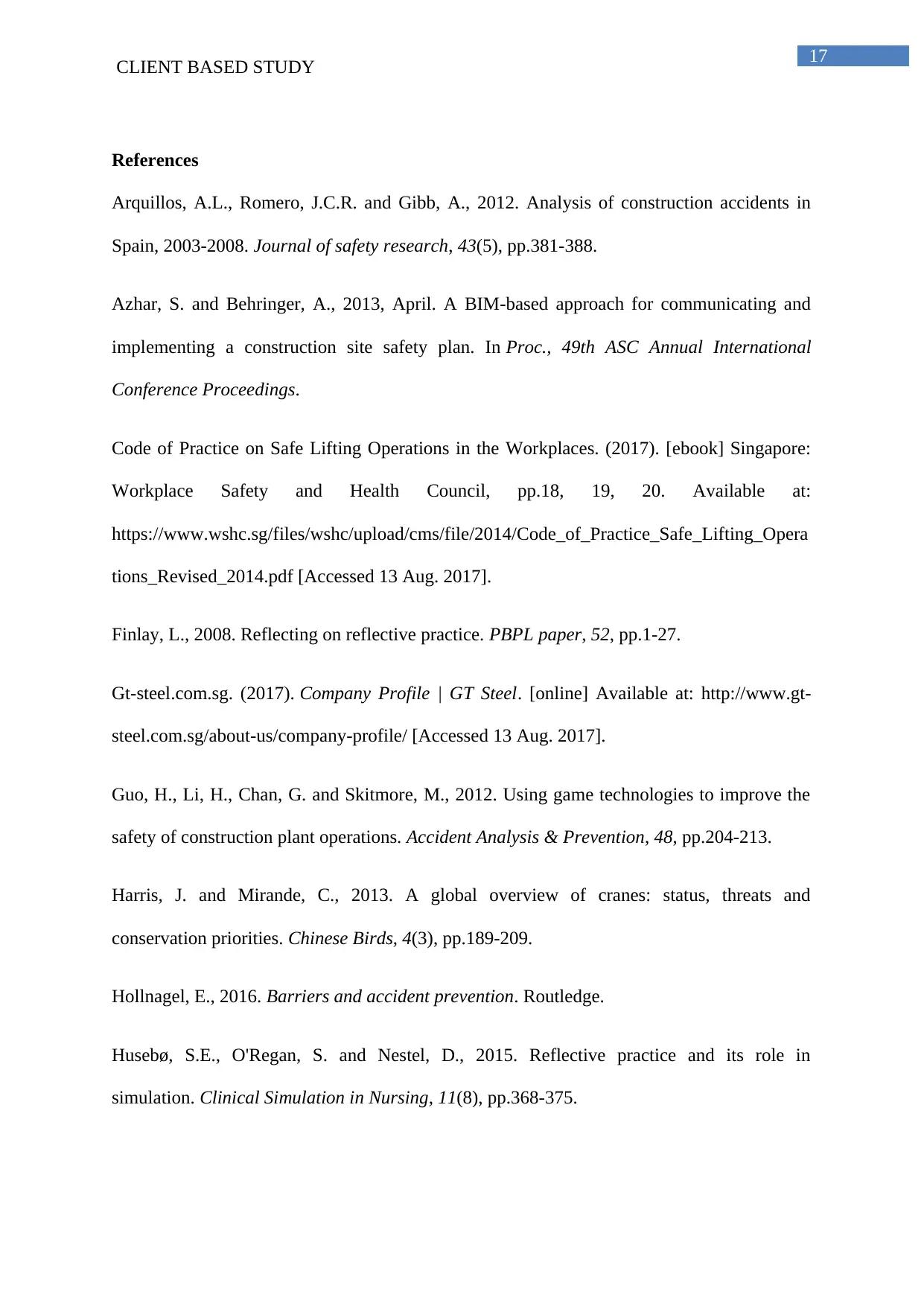
17
CLIENT BASED STUDY
References
Arquillos, A.L., Romero, J.C.R. and Gibb, A., 2012. Analysis of construction accidents in
Spain, 2003-2008. Journal of safety research, 43(5), pp.381-388.
Azhar, S. and Behringer, A., 2013, April. A BIM-based approach for communicating and
implementing a construction site safety plan. In Proc., 49th ASC Annual International
Conference Proceedings.
Code of Practice on Safe Lifting Operations in the Workplaces. (2017). [ebook] Singapore:
Workplace Safety and Health Council, pp.18, 19, 20. Available at:
https://www.wshc.sg/files/wshc/upload/cms/file/2014/Code_of_Practice_Safe_Lifting_Opera
tions_Revised_2014.pdf [Accessed 13 Aug. 2017].
Finlay, L., 2008. Reflecting on reflective practice. PBPL paper, 52, pp.1-27.
Gt-steel.com.sg. (2017). Company Profile | GT Steel. [online] Available at: http://www.gt-
steel.com.sg/about-us/company-profile/ [Accessed 13 Aug. 2017].
Guo, H., Li, H., Chan, G. and Skitmore, M., 2012. Using game technologies to improve the
safety of construction plant operations. Accident Analysis & Prevention, 48, pp.204-213.
Harris, J. and Mirande, C., 2013. A global overview of cranes: status, threats and
conservation priorities. Chinese Birds, 4(3), pp.189-209.
Hollnagel, E., 2016. Barriers and accident prevention. Routledge.
Husebø, S.E., O'Regan, S. and Nestel, D., 2015. Reflective practice and its role in
simulation. Clinical Simulation in Nursing, 11(8), pp.368-375.
CLIENT BASED STUDY
References
Arquillos, A.L., Romero, J.C.R. and Gibb, A., 2012. Analysis of construction accidents in
Spain, 2003-2008. Journal of safety research, 43(5), pp.381-388.
Azhar, S. and Behringer, A., 2013, April. A BIM-based approach for communicating and
implementing a construction site safety plan. In Proc., 49th ASC Annual International
Conference Proceedings.
Code of Practice on Safe Lifting Operations in the Workplaces. (2017). [ebook] Singapore:
Workplace Safety and Health Council, pp.18, 19, 20. Available at:
https://www.wshc.sg/files/wshc/upload/cms/file/2014/Code_of_Practice_Safe_Lifting_Opera
tions_Revised_2014.pdf [Accessed 13 Aug. 2017].
Finlay, L., 2008. Reflecting on reflective practice. PBPL paper, 52, pp.1-27.
Gt-steel.com.sg. (2017). Company Profile | GT Steel. [online] Available at: http://www.gt-
steel.com.sg/about-us/company-profile/ [Accessed 13 Aug. 2017].
Guo, H., Li, H., Chan, G. and Skitmore, M., 2012. Using game technologies to improve the
safety of construction plant operations. Accident Analysis & Prevention, 48, pp.204-213.
Harris, J. and Mirande, C., 2013. A global overview of cranes: status, threats and
conservation priorities. Chinese Birds, 4(3), pp.189-209.
Hollnagel, E., 2016. Barriers and accident prevention. Routledge.
Husebø, S.E., O'Regan, S. and Nestel, D., 2015. Reflective practice and its role in
simulation. Clinical Simulation in Nursing, 11(8), pp.368-375.
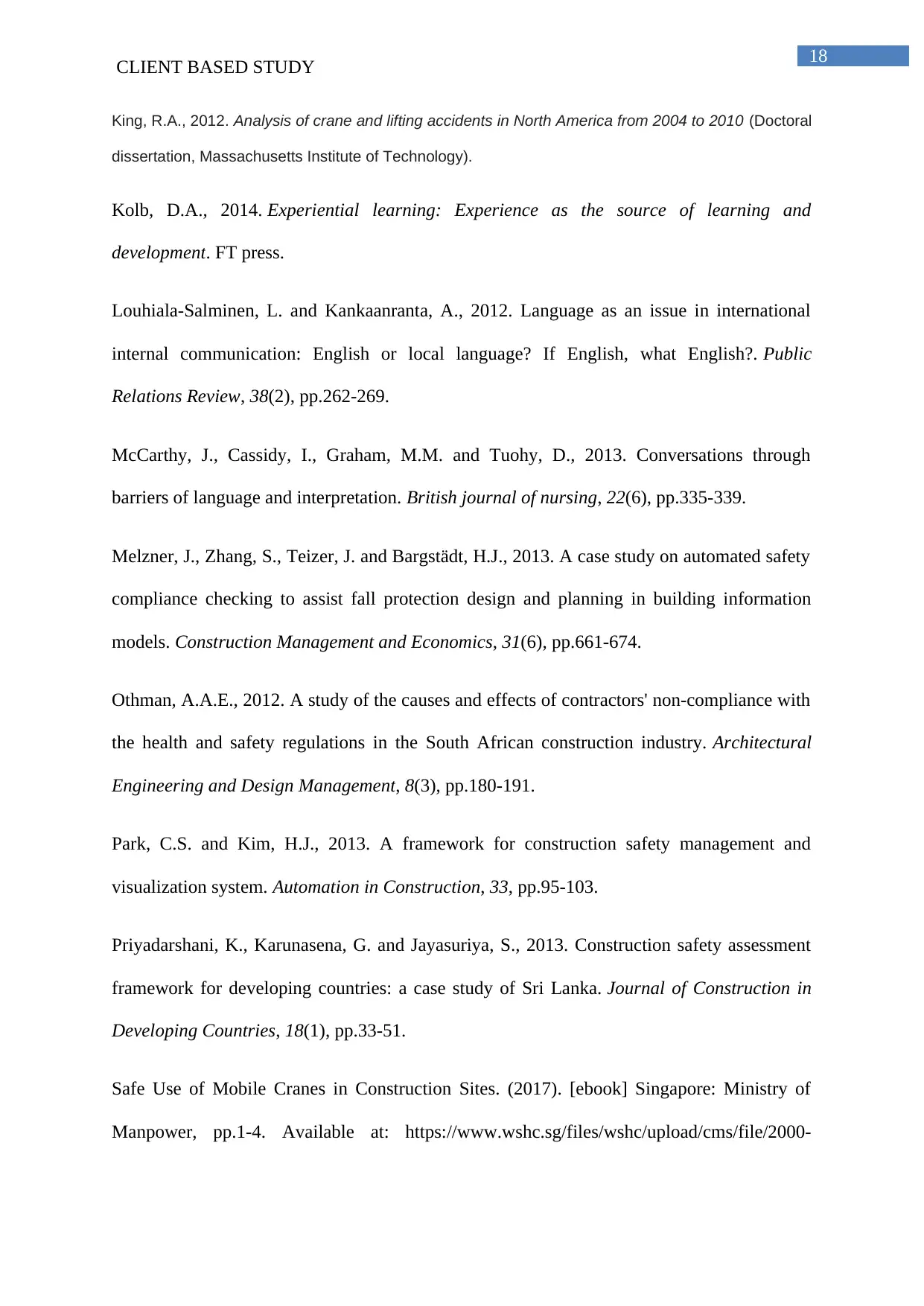
18
CLIENT BASED STUDY
King, R.A., 2012. Analysis of crane and lifting accidents in North America from 2004 to 2010 (Doctoral
dissertation, Massachusetts Institute of Technology).
Kolb, D.A., 2014. Experiential learning: Experience as the source of learning and
development. FT press.
Louhiala-Salminen, L. and Kankaanranta, A., 2012. Language as an issue in international
internal communication: English or local language? If English, what English?. Public
Relations Review, 38(2), pp.262-269.
McCarthy, J., Cassidy, I., Graham, M.M. and Tuohy, D., 2013. Conversations through
barriers of language and interpretation. British journal of nursing, 22(6), pp.335-339.
Melzner, J., Zhang, S., Teizer, J. and Bargstädt, H.J., 2013. A case study on automated safety
compliance checking to assist fall protection design and planning in building information
models. Construction Management and Economics, 31(6), pp.661-674.
Othman, A.A.E., 2012. A study of the causes and effects of contractors' non-compliance with
the health and safety regulations in the South African construction industry. Architectural
Engineering and Design Management, 8(3), pp.180-191.
Park, C.S. and Kim, H.J., 2013. A framework for construction safety management and
visualization system. Automation in Construction, 33, pp.95-103.
Priyadarshani, K., Karunasena, G. and Jayasuriya, S., 2013. Construction safety assessment
framework for developing countries: a case study of Sri Lanka. Journal of Construction in
Developing Countries, 18(1), pp.33-51.
Safe Use of Mobile Cranes in Construction Sites. (2017). [ebook] Singapore: Ministry of
Manpower, pp.1-4. Available at: https://www.wshc.sg/files/wshc/upload/cms/file/2000-
CLIENT BASED STUDY
King, R.A., 2012. Analysis of crane and lifting accidents in North America from 2004 to 2010 (Doctoral
dissertation, Massachusetts Institute of Technology).
Kolb, D.A., 2014. Experiential learning: Experience as the source of learning and
development. FT press.
Louhiala-Salminen, L. and Kankaanranta, A., 2012. Language as an issue in international
internal communication: English or local language? If English, what English?. Public
Relations Review, 38(2), pp.262-269.
McCarthy, J., Cassidy, I., Graham, M.M. and Tuohy, D., 2013. Conversations through
barriers of language and interpretation. British journal of nursing, 22(6), pp.335-339.
Melzner, J., Zhang, S., Teizer, J. and Bargstädt, H.J., 2013. A case study on automated safety
compliance checking to assist fall protection design and planning in building information
models. Construction Management and Economics, 31(6), pp.661-674.
Othman, A.A.E., 2012. A study of the causes and effects of contractors' non-compliance with
the health and safety regulations in the South African construction industry. Architectural
Engineering and Design Management, 8(3), pp.180-191.
Park, C.S. and Kim, H.J., 2013. A framework for construction safety management and
visualization system. Automation in Construction, 33, pp.95-103.
Priyadarshani, K., Karunasena, G. and Jayasuriya, S., 2013. Construction safety assessment
framework for developing countries: a case study of Sri Lanka. Journal of Construction in
Developing Countries, 18(1), pp.33-51.
Safe Use of Mobile Cranes in Construction Sites. (2017). [ebook] Singapore: Ministry of
Manpower, pp.1-4. Available at: https://www.wshc.sg/files/wshc/upload/cms/file/2000-
Paraphrase This Document
Need a fresh take? Get an instant paraphrase of this document with our AI Paraphraser
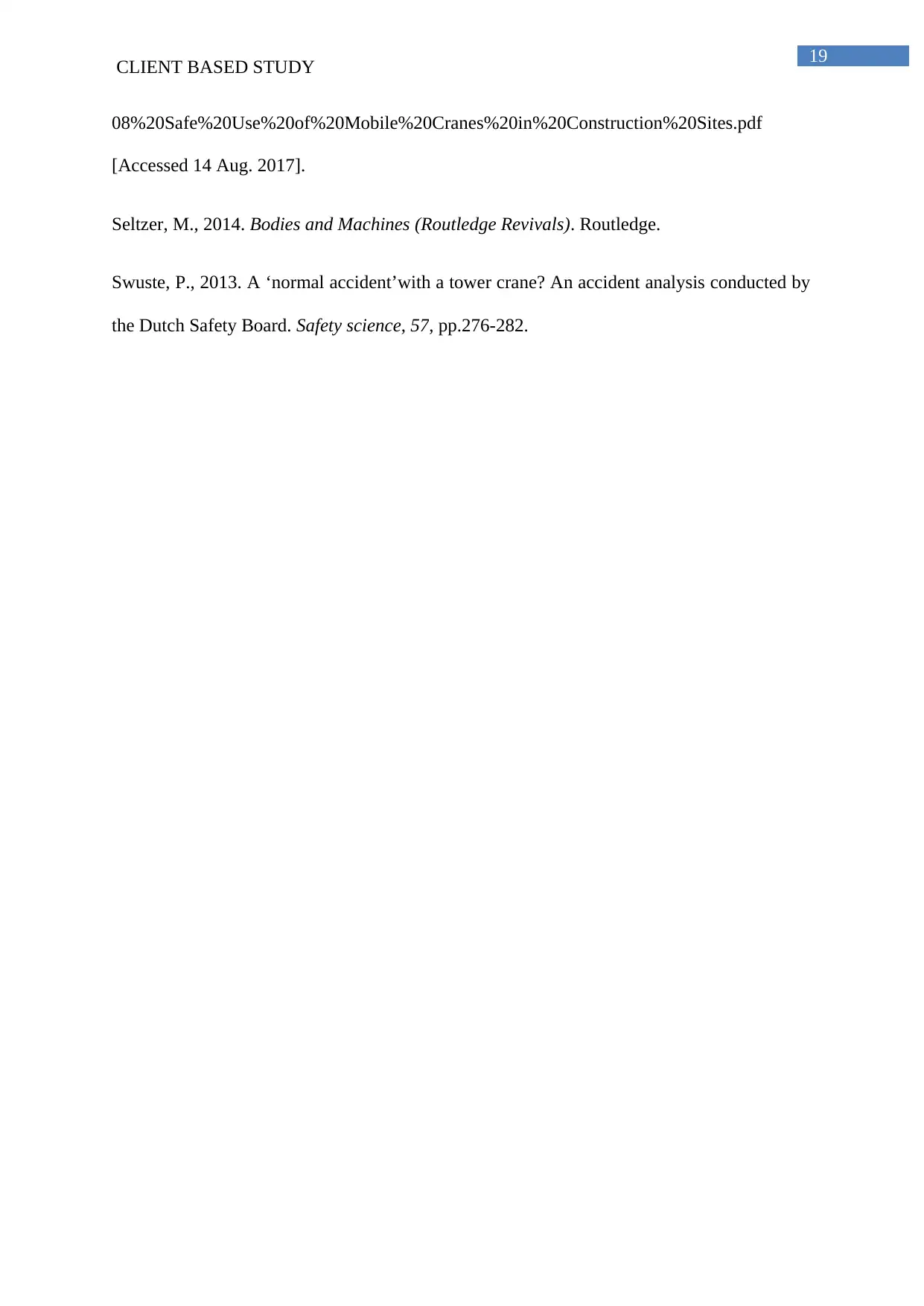
19
CLIENT BASED STUDY
08%20Safe%20Use%20of%20Mobile%20Cranes%20in%20Construction%20Sites.pdf
[Accessed 14 Aug. 2017].
Seltzer, M., 2014. Bodies and Machines (Routledge Revivals). Routledge.
Swuste, P., 2013. A ‘normal accident’with a tower crane? An accident analysis conducted by
the Dutch Safety Board. Safety science, 57, pp.276-282.
CLIENT BASED STUDY
08%20Safe%20Use%20of%20Mobile%20Cranes%20in%20Construction%20Sites.pdf
[Accessed 14 Aug. 2017].
Seltzer, M., 2014. Bodies and Machines (Routledge Revivals). Routledge.
Swuste, P., 2013. A ‘normal accident’with a tower crane? An accident analysis conducted by
the Dutch Safety Board. Safety science, 57, pp.276-282.
1 out of 20
Your All-in-One AI-Powered Toolkit for Academic Success.
+13062052269
info@desklib.com
Available 24*7 on WhatsApp / Email
![[object Object]](/_next/static/media/star-bottom.7253800d.svg)
Unlock your academic potential
© 2024 | Zucol Services PVT LTD | All rights reserved.